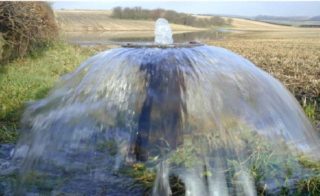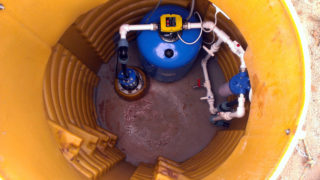There are frequent cases when, when drilling a well, specialists find themselves in a reservoir with a huge flow rate (productivity). In this case, it is necessary either to stop the self-flowing from the well by plugging and start searching for a less dynamic horizon, or to equip the hydraulic structure in a special way. But such a source gives certain problems in both cases.
What is self-flowing wells

Self-flowing wells are called a kind of anomalous phenomenon, in which a water resource under high pressure rises itself and pours out even without the use of pumping equipment. Often the liquid reaches the surface of the earth on its own, making it difficult to equip the well. Reasons for self-flowing wells:
- Drilling directly at the foot of the mountain range. It is here that powerful pressure horizons are located.
- Getting into a reservoir that has no alternative resource outputs (natural springs, geysers, etc.).
Sometimes self-flowing wells can be a mistake of specialists, made during the installation of the casing. Fluid will flow out of the annulus. In this case, it is necessary to immediately file complaints with the drillers and demand the elimination of defects.
Advantages and disadvantages of a self-pouring source
If a hydraulic structure arbitrarily supplies a resource under high pressure, the following positive aspects can be found in this:
- no need to purchase an expensive deep-well pump and accessories for it:
- constant high flow rate of the well: you can not think about the productivity of the source and consume as much water as you want for irrigation, household needs, filling the pool, etc.;
- the opportunity to earn extra money on the surplus of artesian water, offering it to neighbors.
However, the self-flowing source has a number of disadvantages. These include:
- technical difficulties during drilling;
- difficulties in arranging the casing, head and caisson;
- freezing of the upper part of the well in winter and the need for additional insulation, which entails additional costs;
- the risk of casing rupture when it freezes, which will entail additional repair costs.
Despite all the shortcomings, more often the masters resort to further arrangement of the source, and do not decide to drown out the self-pouring well.
Arrangement of the source

When it hits a self-flowing well, they rarely decide to plug (plug) a hydraulic structure by pouring large volumes of concrete mortar with an admixture of Portland cement into it, since here additional costs will have to be borne for drilling and setting up another mine. In addition, such liquidation is possible only with a low overpressure. If it is too high, it is impossible to stop self-flowing in this way. Then the water can find another way out on the site. It is more expedient to deal with a self-pouring source in this way:
- equip a special caisson;
- make a lateral outlet channel below the level of soil freezing;
- raise the casing by several meters.
In the first case, you will have to dig in the well pipe two meters deep for the installation of the caisson.Pouring a concrete base is required under it. It will also play the role of additional protection against freezing of the column. The walls of the caisson are made of polymer or reinforced concrete rings, always insulated from the outside. The upper part of the barrel should be plugged tightly with a specially mounted head. In the caisson, a branch is made from the casing on the side, below the level of soil freezing. From this place, you can pull the traditional water supply to the house, bathhouse, pool, etc.
It is important to make an additional branch with a valve for a specific well pressure. From it you need to pull a flexible hose directed to the nearest body of water. If this is not done, excessive stress in the system will force the water sooner or later to find another outlet under the base of the house, around the casing, etc. If there is no natural reservoir nearby, it is advisable to equip an artificial drainage zone.
If the decision is made in favor of increasing the height of the casing, more often an additional 2-3 meters is enough to pacify the underground self-flow. From here they carry out the standard wiring of the water supply system. It is important to take care of high-quality insulation of all upper elements of a hydraulic structure.
Another option for a self-flowing well is the installation of a special plug, which is placed in the pipe below the level of soil freezing. The water remaining at the top is pumped out. You can then use the side outlet as a standard water supply system. But it also needs a back-up drain to reduce the pressure in the system.
Before eliminating the excessive flow rate of water in the well, it is better to consult with specialists. In case of illiterate actions, the source will continue to pour out liquid on its own, swamping the area.








